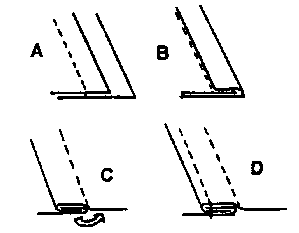

If cloth was of exactly the right size for your use, and if it had infinite strength and manageable stretch over its entire width, there would be no point to this column, and I'd have to think of something else to write about. Fortunately for me, the world of cloth isn't that perfect, and even if it was, the fabric we'd see wouldn't look enough like period fabric to suit us re-creationists. So sew we must.
Every design is a compromise between weight and strength. We want to use the lightest cloth possible, to have less weight to carry around, less load on our various methods of transportation, and less strain on the tent's frame. But since lighter cloth is more susceptible to tears, abrasion, and stretching, we can't use it "off the roll" without reinforcing the areas that need it most.
Tears, abrasions, and stretching are the big three tent-killers. Tears happen either because the fabric suddenly sees a lot more strain than it usually does, and more than it's designed to take. This strain could be due to something else on the tent failing dramatically (like a pole or a rope) and transferring more of the normal stresses of a tent onto the hapless fabric, or it could be caused by point-loading --- the familiar tent pole (or lance-head) going through the fabric where it isn't supposed to.
To guard against these things, reinforcement must be provided. Like most people with backgrounds in sailmaking, I call these reinforcements "patches" even though, strictly speaking, they don't "patch" or repair anything. We use them to beef up those areas where we expect to see more stress than the fabric alone could handle.
Patches
Patches can be single layers of cloth or multiple layers. When using multiple layers (or very heavy cloth), care must be taken not to go from a thin area to a very thick area. Such a sharp transition will ensure that the border of the patch will flex more than the usual area, and flexion eventually results in the cloth weakening. It's exactly the same as bending that coat hanger wire back and forth to break it, although the weakening takes place over a much longer period of time. And if the area is shock-loaded, I'd bet dollars to donuts that the fabric will fail right at the transition area where the thick cloth, stretching not at all, passes all the stress it encounters on to the adjacent thin layer.
Look at the corner of a yacht sail. You'll see many layers of cloth at the grommet or Inox ring or whatever is used to attach the sail to the rest of the boat. Then you'll see the layers disappear, one by one, as you travel outward from the grommet. On a well-made tent, you're likely to see a similar system at major attachment points like the roof peak, where the grommet goes through the tent fabric, plus a layer or two of cloth on top of the tent fabric, to many layers (or webbing) at the peak itself.
When you sew patches to the cloth, try not to run the stitch lines at 90 degrees to the angle of greatest tension. Running a stitch line this way is bad because it loads the line at a point where it is weakest, and where any stress on the fabric will result in the thread "combing out" the fabric, reducing its integrity even more. Instead, try to run the seam lines parallel to the tension lines, or at least not much above 45 degrees from parallel.
What to use for patches? Most people use more of the cloth the tent is made of. In most cases, that works fine, and the patch material will probably stretch and age like the main fabric, too. You might eventually reach a thickness where your sewing machine has trouble going through all that stuff, but those areas can usually be hand-seamed with strong thread and a stout needle. (Sailmakers use a "palm" -- a sort of fingerless glove with a concave surface on the palm, dimpled like a thimble, so they can use the force of their wrists and arms to drive the needle through. These doodads are getting hard to find, but if your local awning shop, leather emporium, or sail loft can't find a supplier, let me know and I'll get one for you. They come, unsurprisingly, in left-hand and right-hand flavors.)
You can also use leather (eight-ounce leather works well), although with leather patches you have to pay more attention to keeping the leather oiled and reasonably supple. If the leather gets dry and hard, it not only becomes crumbly and brittle, but it also creates, at its border, the going-from-stiff-to-soft transition I described earlier.
At really high-stress areas, where center poles are going through the fabric, I use webbing a lot. It's relatively low-maintenance, extremely strong, and usually used in areas where it isn't too visible.
 the best type of seam to use is a flat-fell seam.these are made by overlapping the edges, with the "outsides" of the panel (or the "right" side, for you sewpeople) against each other. the lower edge protrudes from the upper panel about 1/2" to 1". Then sew a line of stitching that same distance (or a little more) from the edge of the upper pane. The protrusion is then folded to the stitch line, the panels folded back with the sewn edge folded so that the protrusion ends up inside the seam, and another line of stitching sewn to hold the flap down. This results in a strong, weathertight seam with all the cut edges concealed.
the best type of seam to use is a flat-fell seam.these are made by overlapping the edges, with the "outsides" of the panel (or the "right" side, for you sewpeople) against each other. the lower edge protrudes from the upper panel about 1/2" to 1". Then sew a line of stitching that same distance (or a little more) from the edge of the upper pane. The protrusion is then folded to the stitch line, the panels folded back with the sewn edge folded so that the protrusion ends up inside the seam, and another line of stitching sewn to hold the flap down. This results in a strong, weathertight seam with all the cut edges concealed.
Try to avoid seaming horizontally. If you can't avoid it (for instance, when attaching a valance to a canopy, arrange it so that the outside fold is lapped downward. When assembling the seam, put the lower panel on the bottom, wrong side down, and put the upper panel on top, wrong side up. It's the lower panel that provides the seam's protrusion. If you did it right, there will be only a single stitch line showing on the outside.
The best tents are made with the seams oriented along the lines of the greatest tension. Tentmasters calls this technique "seam engineering," but the technique has been used by sailmakers and tentmakers for centuries. By orienting the seams this way, the seams themselves can act as reinforcements, the extra layers of cloth acting to limit the stretch along those lines. In fact, sailmakers often create a "false seam" simply by pinching the cloth to form an overlap and then sewing the overlap down. The result look like, and perform like, a true seam, although there is only one piece of cloth involved.
If the seam alone might not provide enough strength, you can make it stronger if you "rope" the seams by running a length of rope or webbing through the pocket formed inside the seams. The rope or webbing is usually sewn to the fabric along its entire length, although in some special applications, the rope is only sewn down at the ends. You'd use the latter technique where you feel you might have to replace the rope from time to time, or where you might want to adjust the rope's length to compensate for any stretching or shrinking of the fabric. The need for this compensation actually illustrates the main drawback of roping a seam -- it may make the seam stronger, but it doesn't do much to control stretch in the areas near the seam. And if stretch occurs, usually due to extreme wind loads on the tent, there may not be enough tension on the fabric to remove the bagginess. The result is a tent that luffs in the wind, and no amount of tension on the canopy will remove the bagginess until the rope inside the seam is loosened and retied at the point where the canopy is taking some of the strain again.
Hems are a sort of specialized seam at the edge of the cloth, but they serve the same function of providing more cloth where tension loads are greater. Of course, they also serve to finish the edge of the cloth so it doesn't unravel, but that's a secondary benefit. Even when I'm using the selvage of a cloth like Sunforger, I fold it over to form a hem, because even it it doesn't unravel, the edges of the cloth are going to get a lot of strain and more abrasion, and the selvage isn't really much different in composition than the rest of the cloth ... a little more tightly woven, it is true, but not enough to strengthen it appreciably.
Cloths like Pyrotone and Fyre-Coat need hemming, because they don't have a true woven selvage. Instead, the cloth is simply trimmed to size, and it's the acrylic finish on the coat that keeps it from fraying for a little while, but certainly not forever. Similarly, urethane-coated nylons will resist fraying at first, but will eventually fray. (But you're not using nylon for tent material, are you?) And rest assured that heat-sealing any of these cloths will not keep them from fraying for long, regardless of what anybody tells you.
On my sunshades, there's a four-foot length at the bottom of each flap which is cut slightly on the bias of the cloth. The angle of the cut is enough to cause the flap to stretch and distort, so I prevent that problem by cutting two strips of fabric, 2" wide, on the fill (or weft) of the cloth and sewing that strip into the seam of the hem. I guess you could call the strip a sort of "anti-bias" tape. (I'm telling you this because there's no way of knowing, just by looking, that the strip was inside the seam, but it's attention to little details like this that make the difference in the way a tent looks and works.)
Not that everything I do has such a pure and noble purpose. I confess that sometimes I've put patches in places where I didn't think they were necessary, but where people expected to see them. (And, no, I'm not telling you which patches, on which tents!) They serve the same purpose as the columns under the dome in London's Saint Paul's Church. When Christopher Wren designed it originally, there were no columns in the design, because Wren figured that the structure of the church itself would support the dome.
The church fathers didn't agree. They didn't trust Wren's mathematics, and told him that they were either going to have their columns or else find another architect. Well, then, replied Wren, if it's columns you want, it's columns you shall have. And columns they got.
But according to the story I was told, Wren had the last laugh. The columns don't touch the ceiling. They are, in fact, half an inch too short.